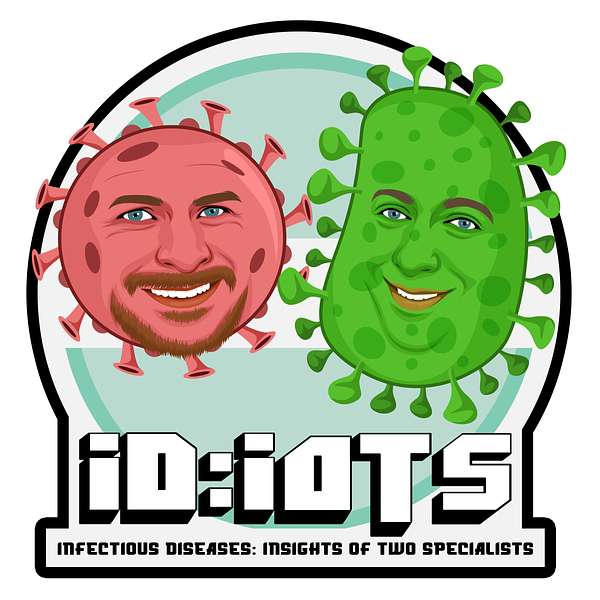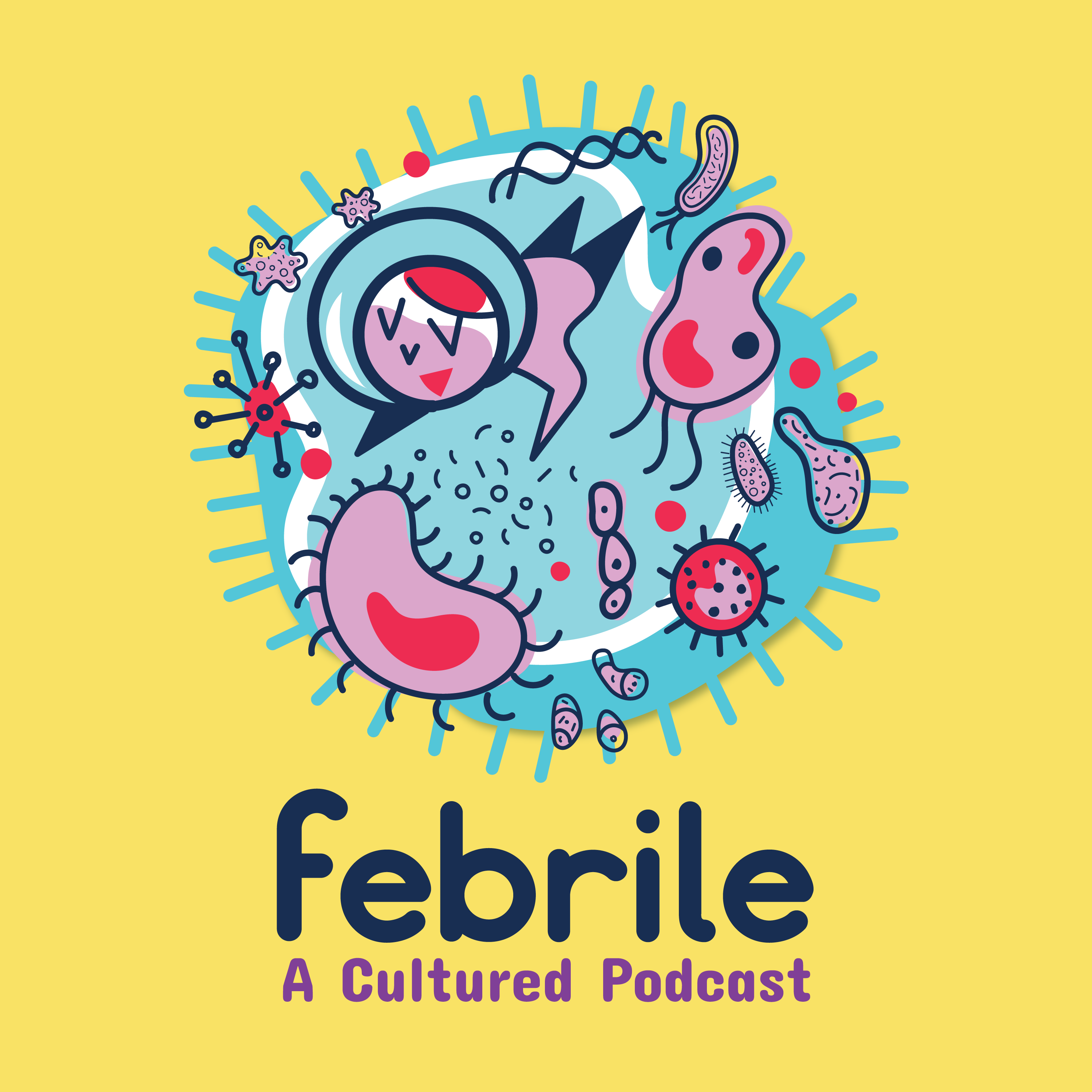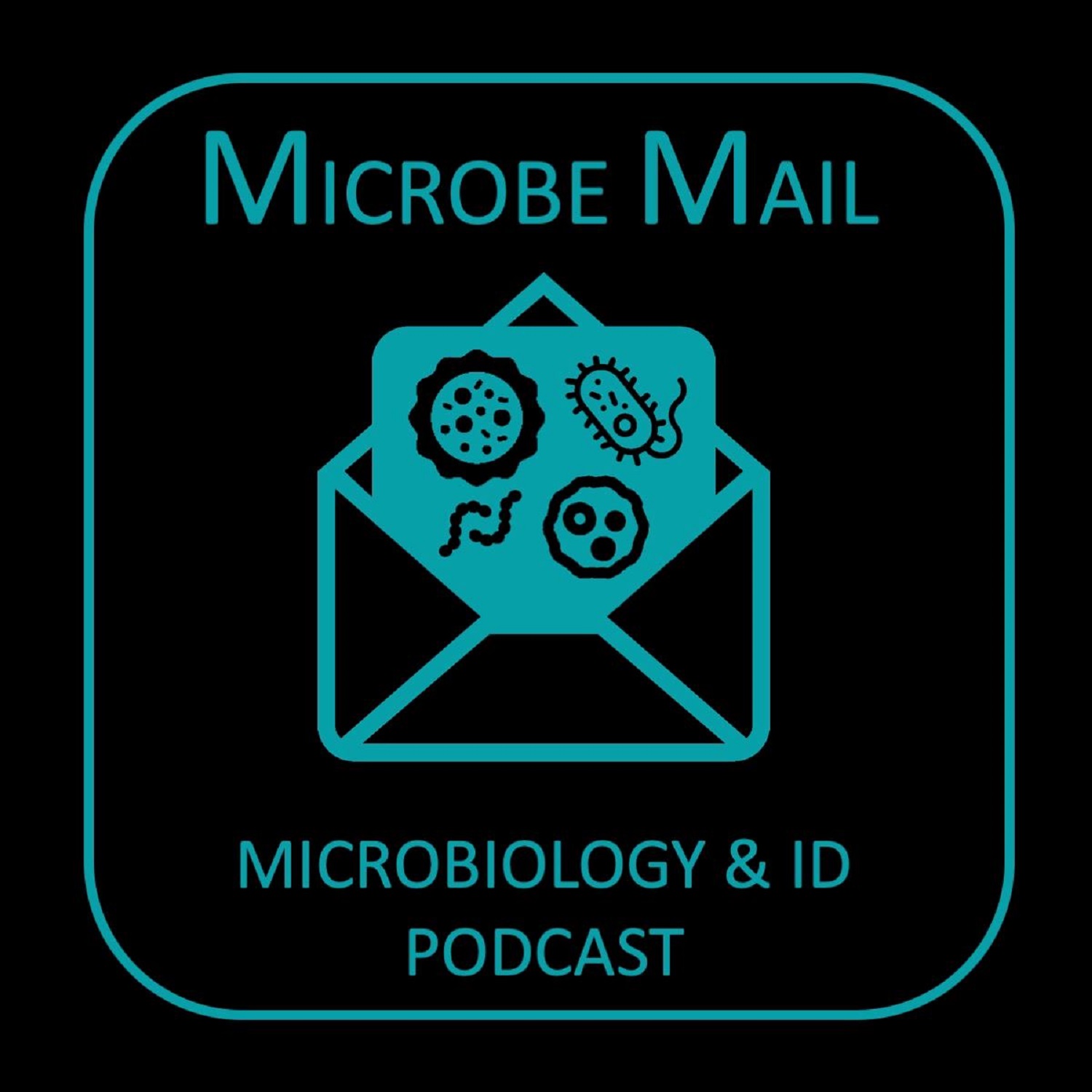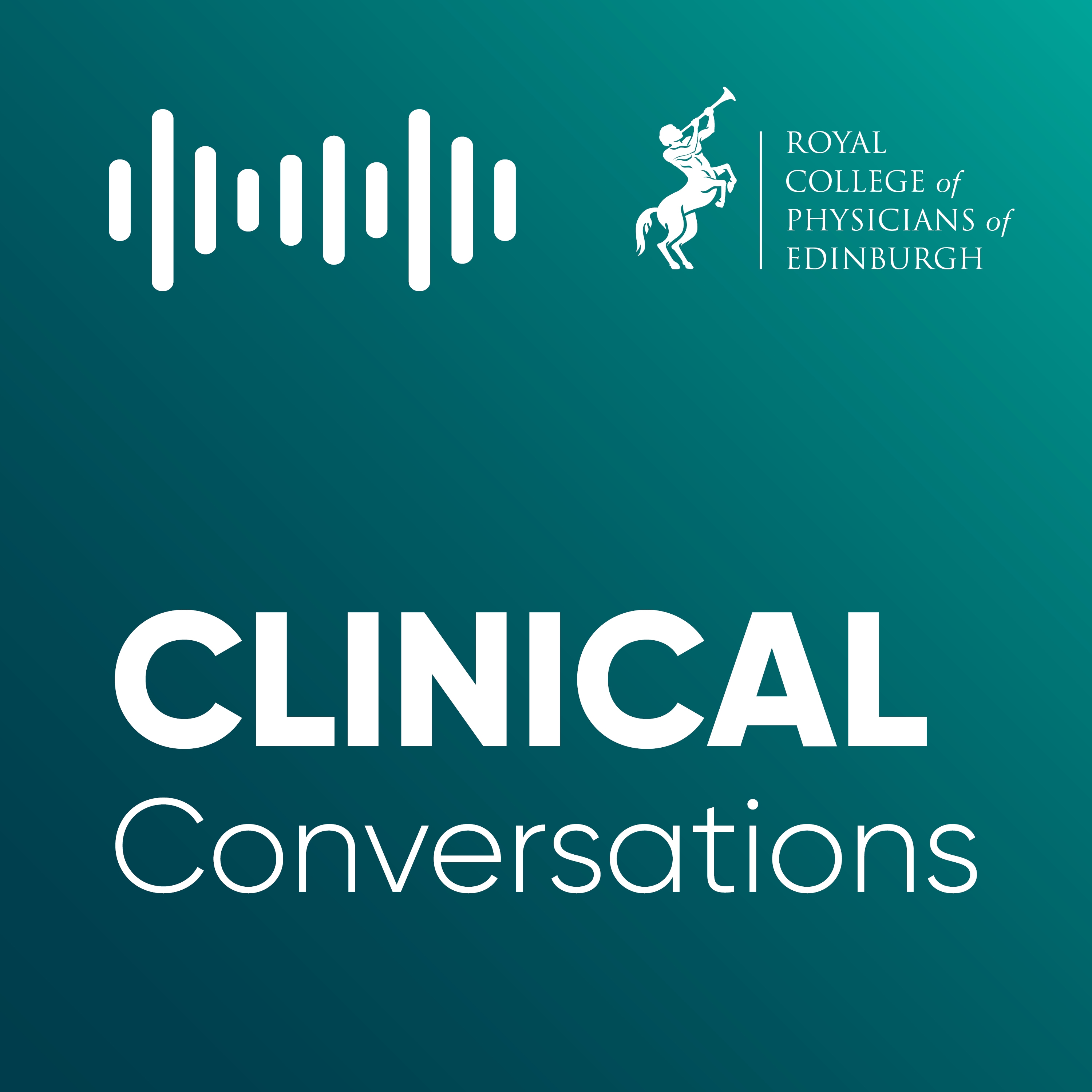
ID:IOTS - Infectious Disease Insight Of Two Specialists
Join Callum and Jame, two infectious diseases doctors, as they discuss everything you need to know to diagnose and treat infections. Aimed at doctors and clinical staff working in the UK.
Episode notes here: https://t.ly/8DyqW
Queries, comments, suggestions to idiotspodcasting@gmail.com
ID:IOTS - Infectious Disease Insight Of Two Specialists
74. Nobbling the Nonfermentors: Burkholderia mallei - Glanders
In this final episode of the Nobbling the Nonfermentors mini-series, Jame and Callum discuss the (mostly historical) pathogen Burkholderia mallei, causative agent of Glanders.
We did it. We got to the end.
Nonfermentors... Nobbled.
Questions, comments, suggestions to idiotspodcasting@gmail.com or on Bluesky @idiots-pod.bsky.social
Prep notes for completed episodes can be found here (Not all episodes have prep notes).
If you are enjoying the podcast please leave a review on your preferred podcast app!
Feel like giving back? Donations of caffeine gratefully received!
https://www.buymeacoffee.com/idiotspod
Callum, how you doing? I.
Callum1:I'm good. I think our loyal listeners will be glad to hear. That we're going to have a gander through this episode. You could say We're gonna have a lander.
Jame1:I see. Oh, is that the pun? A lander.
Callum1:Yeah. A lander. Yeah, because we're glad to gander.
Jame1:Oh, dear. Hang on, hang on. Callum, just let me take this, chloramphenicol, eye drop. I've got a bad case of conjunctivitis. I've got a real smelly eye. A and that reminds me Callum, what are we talking about today?
Callum1:Is that because you've been to Mali So you've got a Mali eye
Jame1:Ugh, no, no, no,
Callum1:that does make more sense than your one
Jame1:no, no. My one was fine.
Callum1:No, it was not fine. None of them are fine. They're all bad.
Jame:Okay. That's fair enough. Go ahead, Cal. What are we talking about today?
Callum1:We're talking about
Jame:I.
Callum:Berk Dim. I.
Jame:Indeed the last of our nobbling, the non fermentor series, Berk Didi Alai cousin to Beel, Didi Psal, which we've just discussed.
Callum:It is sad. You know when you, when you're reading a good book and you get to the last couple of pages and you realize the book's going to end, that's how I feel about nobbling the norm for mentors.
Jame:Yeah, I, I feel slightly differently. I, I'm sort of sick of that book and I wish that book would die.
Callum1:But you have to finish it even though you're not enjoying it.
Jame1:I have to finish it, but I don't like finishing it. It was like that time that I read Lord of the Rings. That's right. Callum. I said it.
Callum1:I'm just glad you read it, man. That's fine.
Jame:Alright. Too much poetry. I. And I didn't like Tom Bombadil. Okay. Yes. So gland, uh, whose the thankfully hi. Mostly historical, infectious disease is caused by Berk Deia Mai. This is the last Berk, Deia and indeed the last non fermentor that we're going to talk about in this, mini, mini series. Callum, do you know anything about this? Have I take it? You've never treated a case. Neither have I. Do you know anything about this?
Callum1:Not until I read a little bit in preparation for this. I, I think I'd heard of it as a historic, I'm got into history and I think I'd read about it. And like it comes up in certain old novels and stuff, but I,
Jame1:Oh, does it really?
Callum1:didn't, yeah, I'm trying to think. Is it mentioned in Tolstoy or something? I can't remember. I feel like it, it's like a passing familiar in the sense of, oh yes, that is old timey disease. I.
Jame1:Yeah. Yeah. A bit like consumption, with t's old name. yeah, that, that's interesting because up until the 20th century, this was an incredibly important disease to control. Because it is a disease primarily of horses and other sort of beasts of burden and up until, the invention of the telegraph and I, I suppose semaphore. If you wanted to communicate something or transport something, a guy on a horse was by far and away the fastest way to do it. And it dominated transport, up until the invention of kind of motor vehicles. And so having a disease that affected horses, if you had an outbreak, that was, it was vitally important to control it, particularly in sort of military settings. so I, I think call, we're gonna switch out the order here, but let, let's just start with the taxonomy and then we'll go and talk about the history. Is that okay?
Callum1:But yeah, you're the, the assistant deputy sub cohost.
Jame1:Yes, that indeed that is my official title. Thank you very much, for, letting me take part in this, project of yours, Callum, So, unbeknownst to me, when we recorded last episode at Malai is part of the pseudo mai complex. and I didn't know this. And so that is, composed of, uh, well, Callum, it wouldn't be a nobbling, the non fermentors mini series if we didn't do a classic. We list all the members, of a complex one after the other. You up for this? It's the last time we'll ever do it. Callum.
Callum1:Oh no. Well, we can do it for other groups, I guess,
Jame1:Well, I suppose we could, but not for
Callum1:won't be the same. It won't be the same
Jame1:It won't, it will not be the same. I'll start Thailand, pseudo Mali, and that's the complex
Callum1:That's, that's a simple, it's not a complex.
Jame1:Yeah, it's pretty simple. It's a simplex, really. but, these organisms are all, are all very closely related to each other. And in fact, phylogenetic analysis, which just very strongly, that Mai, which was identified by humans first is an offshoot, a mutation of pseudo mai, which is the parent species. just to make things a bit more confusing. I don't know what Thailand Ansys, relation is to these two. It's not a significant pathogen in humans and in, in the last
Callum1:can be found on Maldi. And when you see an idea of Berk do or Thailand dentist, a Maldi, you should think, is this pseudo mal?
Jame1:oh, well, Luke, who was listening last week Oh, fantastic stuff.
Callum1:I'm a loyalist, sir. Shame
Jame1:Um, yeah. And, and the main difference in the, the very quick, uh, uh, identification difference between them would be pseudo oxide is positive. Uh, alii is oxides negative and I don't know what Thailand answers is. Sorry, I didn't bother looking up. Callum, do you want to take us through the history of pseudo mal,
Callum1:so 4, 2, 5 BC glands was described by Hippocrates, and as James said already, this was significant throughout history because of the importance of horses in military action as cavalry. And the name glands comes from the old French dress. Or kilometers, which is, means glands, which is not surprising. It's the same route.
Jame1:Yeah. Yeah.
Callum1:And if you don't know what glands are, it's a of colloquial term for lymph nodes,
Jame:okay.
Callum:Odium Mai is listed by the CDC as a category B bio-terrorism agent, and it's not been a human pathogen in the uk. The last diagnosis here was 1928. And the last di, so it historically was around and it was, but it was last diagnosed in the US much more recently in 2000. But that was a lab exposure event. Tying back to it being a sort of lab hazards like pseudo Mai.
Jame1:yeah,
Callum1:And prior to that, there had been cases in 1945, which was again the lab exposure in 1934, which was the last natural infection in the us and I believe it's been applied in bio warfare.
Jame1:Yeah, actually the, so, the 1945 exposure, there were some, but not all sources said that was part of bio weapons research on behalf of the us. So this was, it was happening in the middle of World War II and other, articles didn't say that. including the article that I've put in the prep notes,, but the history of this used as bio warfare is really interesting and there are, suggestions that it had been used. back in ancient history as a bio warfare, agent, hundreds or even thousands of years ago. But more recently, there were in World War I, the Germans were, deliberately infecting, Russian horses on the eastern front. And there was a suggestion that they'd also done it to French cavalry.'cause if you're, I wondering what horses were doing in World War I at the beginning of the war and even in the middle of the end of the war, there were still loads of, horses being used, maybe not in cavalry as such.'cause very quickly it, was determined that horses and machine guns don't mix very well. But, in terms of transport,, they were really important right up until the end. And so they, that they then became a weak point that could be exploited. And, there's a quote about a pa a German, suggested spy called Anton Dilger. And, I've included a quote from the Wikipedia article about Malaya being used as bioterrorism. He was, somebody a German agent who was sent to the US 1915 carrying cultures of Bmai, and set up a lab at his home and then used Baltimore Dog Walker. Dock workers to infect horses with glands. Because they were being shipped to the UK to then be used as part of the war effort. People suspected that he was a German agent, but he was never arrested. And in fact, he, at, in 1918 fled, the country to avoid arrest. Unfortunately, Callum, he fled to Spain where he caught flu and promptly died.
Callum1:Oh.
Jame1:And then in the early eighties, the USSR was accused of using B Malai against the Afghani forces, the mujahideen because again, horses were a significant part of how they got about and waged a gorilla war against the occupying forces. Why don't you take us through the epidemiology. Where did we find,
Callum1:Yeah, it used to be worldwide as we. Mentioned there, but as horses became less important, the disease was eradicated, but is still present in Africa, Asia, and the Middle East and Central and South America,
Jame1:The tropics and places where horses might be still used for transport and where there are large populations of them. Yeah. So yeah, it's it's an interesting disease coming onto where we find it growing. So it's a disease predominantly of what's called solared. So those are the things that go on one toe as opposed to cloven, hoofed animals like, deer and things like that. So that would be horses, donkeys, and mules, which are half horse, half donkey and then camel lids. So anything that's a camel sorry. Any member of that family? Any member of the family came, lids that would that's camels as you know them today. And llamas and alpacas too, you can also find them in contaminated feed and water. Sorry, KA, if I just blown your mind about the fact that s an alpacas are came lids.
Callum:Premier Animal Podcast.
Jame:Camel's actually evolved in North America, migrated across the Bering Street, then became extinct in in the plains as the environment became more unfavorable to their lifestyle. But then they moved south into South America and evolved into Amazon alpacas and camel's thrived in the plains of kind of East Asia and Africa.
Callum1:This is the sort of stuff that we mentioned in our, when we take a history from a patient infectious disease. How detailed we go?
Jame1:Alright, fair enough. Callum, what are the risk groups for acquiring Landers or Bmai?
Callum1:Yeah. As you'd expect, I bring this back to a human infectious disease episode. So the people that are in close contact with horses and, solar pads and camelo. So that's the vets, horse caretakers, so fair farers and stable hands. Laboratorians, equine butchers, abattoir workers, and really the exposure is the most significant exposure animal is horses. And that's because the horses are more prone to chronic or latent infection, and donkeys have more acute infection.
Jame1:Yeah. That's interesting fact actually about the, how it hits the animals differently.
Callum1:Yeah, you always need to ask if it was a donkey or a horse they had contact with
Jame1:And what about transmission, Carl? How do you
Callum1:well
Jame1:How does it transmit to humans? Yeah,
Callum1:Yeah. The, so the infected animals have fluid I presume, is that from lesions?
Jame1:It's from the respiratory tract. Yeah. So they've got how I'll talk about how it affects animals in the clinical syndromes bit.
Callum1:Yeah so infected respiratory fluid, sometimes dust from infected bedding would be another root. So I guess globally farmers are at risk, a lot of zoonoses, so infections associated with animals. So yeah, as we said, horses, but other solar pads, camels and goats. You can also get inoculation through skin cuts, abrasions or through mucosa. And human to human transmission is rare, but apparently possible.
Jame1:Yeah, very rare. Yeah. And the how it affects horses say it's quite nasty. So it's a disease of the respiratory tract really, and it can lead to ulceration of the respiratory tract. The glands go up big on the horse on the neck of the horse, which gives it its name. And that's mostly how you identify it. But you can get these horrible tules. And because horses can't breathe through their mouths. They only breathe through their nose. They don't have the kinda joined up gi and respiratory tract that we have. Cal the, if the ganders becomes bad enough, the horse can start to suffocate is really nasty or can be really nasty. So yeah. So what about the clinical syndromes in humans? So we're gonna divide them. It's really similar. Yeah. And them being, they're very closely related, phylogenetically so that, that would make sense. But there, there are some differences really. The localized infection, usually after inoculation will. Result in ulceration from the skin and localized lymph nodes. So it does affect the lymph nodes more than pseudo. It does. And if that is left unkept, then it can ulcerate and turn into an abscess that separates I. If the mucus membrane is vented. So if it gets into your eye, you just get oid hyper production from from the site. So if that's the eye, you'll get lacrimation and light sensitivity. And if left untreated, then one to four weeks afterwards you can get disseminated at disease that we'll talk about shortly. The. Most common presentation is acute glands, and that has a one to 14 day incubation period on average. And it will start with ulceration of the upper respiratory tract and then. Nodules will develop in the lung and if left untreated, that will lead to pneumonia, abscesses and local empire. And the symptoms are, as you would expect, cough, fever, muscle aches, or prominent feature chest pain headache, light sensitivity, upper respiratory tract discharge. And then it's really interesting because that 1945 outbreak with the lab workers, the inoculation events were all. Inhalation because of substandard lab practices that you wouldn't get away with these days. And because of that. They were really tightly monitored and when the symptoms came on, they were documented extensively. And so we've got really good timelines for this. And the reason I mentioned this is that in acute landers, the patients can then transiently feel better at about the seven to 10 day work, and then they'll get a second wave of symptoms where they'll feel worse. And if they aren't treated at that point, it will lead to dot, dot dot disseminated infection or septic cmic glands. And that's, when it spreads to the blood, that can happen at the time of acute glands. So you can get pneumonia with bloodstream infection or can happen anything up to two weeks afterwards. And it can also be secondary to skin disease. But that's got a longer Sort of timeline of one to four weeks. And if left untreated, they'll die within seven to 10 days. Yeah. And then lastly to say is that there are some people that have chronic glands that's been described. The incubation period is on average about 12 weeks. I. And that is usually skin and soft tissue. So they'll get abscesses in the skin of the arms and legs, but also in the musculature. So it diss, descends and it can disseminate to lung, spleen, and liver. So similar to Melo and also similar to meite, it can be very chronic. So there have been cases that have been lasted sort of 25 years. So the patient is not dead, but they still have this chronic disease. And after chronic infection, some people will end up being carriers of bmal eye. I don't know exactly where they will be carrying it, but yeah. So if you've got these conditions, what are your chances of dying of it? So this is a bit difficult. The information is a little bit difficult to parse out Cal because the, disease is not as well described as Melo frankly. But based on current and historical data, the overall case fatality rate is about 40%. For localized disease, it's 20. If you've got pneumonia and you don't treat it, it's about 90% and usually within 10 to 30 days of onset of symptoms. And with treatment, it's 40. And for disseminated disease, untreated is more than 95%, and with treatment it's about 50 as well. And all that averages out to a CFR of about 40% so Callum, take us through the microbiology of this. How do you diagnose it usually?
Callum1:So starting the basics as with all the non fermentors, it's a gram-negative bacillus, and usually on the gram it's straight it's got a slight curve. It's non mortal. And that's in opposition to pseudo, which is motel. So that's a good differentiator. And as Jane mentioned earlier on, it's oxidase negative. You usually culture it from blood sample, sputum, urine, or skin samples like skin biopsies, I guess.
Jame1:Hmm. Yeah. Yeah, yeah. Yeah.
Callum1:And then agar. So there's no commercially available. Agar as, we talked about pseudo Malia was similar, but it should grow on your standard Columbia blood or blood agar or your chocolate agar at 35 to 37 degrees as if most things, and, it may or may not grow on something like McConkey agar. So a selective acre. And then when you do grow it, the colonies look smooth, gray, translucent. And microscopy. So usually they're in single organisms or it can be end-to-end pair, or it can be palisade bundles, like a palisade wall, and they can exhibit bipolar
Jame1:Mm-Hmm.
Callum1:And then to id. So usually that's on a maloff. And other methods that you could use would be PCR, which is probably a reference lab and multi locus sequence typing. And when they did that's what Jane was referencing earlier on, so that the du mai sequence type was grouped within the ria pseudo mal AI sequence types. Suggesting it's a clone that's diverged at some point in the past. Other things that could be used would be, as with everything, basically 16 SRNA or whole genome sequencing
Jame1:Yeah, all the sm I say that about just about everything, don't they?
Callum1:Yeah, because
Jame1:yeah, for standard labs, it's it's maloff and it's maloff seems to be fine at identifying these organisms. They might get'em mixed them up with each other, but that's about it.
Callum1:It's amazing. I guess one thing that's worth mentioning is given it's a lab hazard, probably don't have a moldy off in your category free lab or your high, your safety lab. So in which case you're probably gonna be doing basic work in that area and then sending off to a reference lab if you're suspecting it. So let the lab team know if you're suspecting. Something like this. Yeah. Yeah. So you wouldn't be doing, unless you're lucky enough to have a maloff in your CL free lab, which I don't think anybody would have. Really?
Jame1:the REF lab will
Callum1:well, may maybe, I don't know. I don't know.
Jame1:Fair enough. So in terms of treatment it's interesting because the I've included a review article that I've got. It's from 2013 or 2014, something like that. Gland, there's an overview of infection in humans, and I I also use the CDCs webpage on gland which has an advice for health professional section. Really, the treatment of it is the same as for Al pseudo, um, and because that's the pathogen that's being re researched a bit more. It's, it's now got UCA break points not so for B malai it's not important enough really to deserve them, but it is usually sensitive to the same agents. So that would be imipenem, keine, tetracycline, ciprofloxacin, smide. So your cotrimoxazole. And the, but the important differences are that it's usually sensitive to aminoglycosides and macrophytes, unlike pseudo. And so that's another way actually, that in the field you can try and identify malai is by documenting a sensitivity to these these two agents. And the recommended agents are the same as for Rader. Pseudo Malai.'cause again resistance isn't really a significant issue. And in fact, I couldn't find anything on resistance for these organisms. Cal. So you were doing a two week Or maybe a bit longer, depending on how severe the infection is. Induction phase with ctdi or meropenem. Again, the regimens as for pseudo ai so see the prep notes on our previous episode for those details. And then an eradication phase with cotrimoxazole, again, dosage in the previous episode, Sonos. There, there are a couple of other suggested regimens in that article, so you can use Doxycycline, 2.5 milligrams per kilogram for a maximum of 100 milligrams twice daily. So that would be, 2.5 milligrams per kilogram with a maximum dose of a hundred milligrams twice daily.
Callum1:I've never weight-based dosing for doxy
Jame1:Me neither,
Callum1:because hundred milligram BD is,
Jame1:The standard dosing these days. Or you can also use MCL 625 milligrams three times a day, or 875 milligrams twice daily, depending on what formulation you have available in your country. And if the none of that was suitable, you could also use macrolides, chloramphenicol, or quinolones, but no dosage was really recommended. I guess you would use the standard or the high dose of whatever those are. Yeah. And that Callum is the end of the Nobbling, the non fermentor, as many CDs.
Callum1:Ferment non fermentor nobbled.
Jame1:Yeah, except for the ones that we've not mentioned that we'll discuss in the future.
Callum1:Yes. So we've talked through, we've had, we've presented episodes on Pseudomonas, OSIS IDEIA Cacia Complex, IDEIA Pseudo Lia, Mai St. Stenotrophomonas, maltophilia.
Jame1:Not even close as Batman's complex,
Callum1:complex.
Jame1:Jesus Christ. How did you pass the part two?
Callum1:What?
Jame1:suppose it was written down.
Callum1:Say again? Cal.
Jame1:We've presented on all of those pathogens
Callum1:I didn't say
Jame1:and that loyal listener.
Callum1:And crab,
Jame1:Yes. And crab. So we've presented on all those pathogens. We hope that you found it useful and we hope that it will be good for your revision in the future. Next week, something completely different. I'm so tired of these bugs. It's time to do something funny.
Callum1:we nobbled the non fermentors? Have they nobbled you, Jim?
Jame1:Well, that's the question.
Callum1:Of next week to find out the answer.
Podcasts we love
Check out these other fine podcasts recommended by us, not an algorithm.

Febrile
Sara Dong
Microbe Mail
Vindana Chibabhai
Let's Talk Micro
Luis Plaza
Breakpoints
Society of Infectious Diseases Pharmacists
Clinical Conversations
Royal College of Physicians of Edinburgh